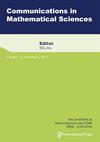Reproducing activation function for deep learning
IF 1.3
4区 数学
Q2 MATHEMATICS, APPLIED
引用次数: 0
Abstract
We propose reproducing activation functions (RAFs) motivated by applied and computational harmonic analysis to improve deep learning accuracy for various applications ranging from computer vision to scientific computing. The idea is to employ several basic functions and their learnable linear combination to construct neuron-wise data-driven activation functions for each neuron. Armed with RAFs, neural networks (NNs) can reproduce traditional approximation tools and, therefore, approximate target functions with a smaller number of parameters than traditional NNs. As demonstrated by extensive numerical tests, the proposed RAFs can facilitate the convergence of deep learning optimization for a solution with higher accuracy than existing deep learning solvers for audio/image/video reconstruction, PDEs, and eigenvalue problems. With RAFs, the errors of audio/video reconstruction, PDEs, and eigenvalue problems are decreased by over 14%, 73%, 99%, respectively, compared with baseline, while the performance of image reconstruction increases by 58%. Numerically, in the NN training, RAFs can generate neural tangent kernels with better condition numbers than traditional activation functions, which provides a prospective for understanding the improved optimization convergence using the theory of neural tangent kernel. The code is available $\href{https://github.com/LeungSamWai/Reproducing-Activation-Function}{https://github.com/LeungSamWai/Reproducing-Activation-Function}$.用于深度学习的重现激活函数
我们提出了重现激活函数(RAF),其动机是应用和计算谐波分析,以提高从计算机视觉到科学计算等各种应用的深度学习精度。我们的想法是利用几个基本函数及其可学习的线性组合,为每个神经元构建神经元数据驱动的激活函数。有了 RAF,神经网络(NN)就能重现传统的近似工具,因此,与传统 NN 相比,它能以更少的参数数近似目标函数。大量的数值测试表明,在音频/图像/视频重建、PDE 和特征值问题上,与现有的深度学习求解器相比,所提出的 RAF 可以促进深度学习优化的收敛,从而获得更高精度的解决方案。与基线相比,利用 RAF,音频/视频重构、PDE 和特征值问题的误差分别降低了 14%、73% 和 99%,而图像重构的性能提高了 58%。从数值上看,在神经网络训练中,RAFs 可以生成比传统激活函数具有更好条件数的神经正切核,这为利用神经正切核理论理解优化收敛性的提高提供了前景。代码见 $/href{https://github.com/LeungSamWai/Reproducing-Activation-Function}{https://github.com/LeungSamWai/Reproducing-Activation-Function}$。
本文章由计算机程序翻译,如有差异,请以英文原文为准。
求助全文
约1分钟内获得全文
求助全文
来源期刊
CiteScore
1.70
自引率
10.00%
发文量
59
审稿时长
6 months
期刊介绍:
Covers modern applied mathematics in the fields of modeling, applied and stochastic analyses and numerical computations—on problems that arise in physical, biological, engineering, and financial applications. The journal publishes high-quality, original research articles, reviews, and expository papers.

 求助内容:
求助内容: 应助结果提醒方式:
应助结果提醒方式:


